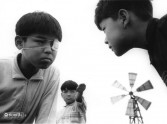
Children in the Classroom
Children Who Draw
Initially conceived as an instructional film on the discipline of troubled children, the Ministry of Education sponsored Children in the Classroom became an important showcase for Hani’s remarkable observational filmmaking and a catalyst for decisive changes in Japanese documentary cinema. Boldly anticipating its Anglo-European counterparts of American direct cinema and French cinema vérité, Hani’s objective camera exhaustively and masterfully interrogated his subjects’ inner worlds. This sensational debut by the then only twenty-six year old Hani stunned documentary and educational film circuits in Japan, who heralded the young director as the emblem of a new breed of film artist.
Children Who Draw explores the delicate chemistry of school children interacting in an art class through a constant juxtaposition of observational black-and-white portraits of the young children with lyrical passages shot in vivid color exploring their imaginative and expressive paintings. Experimenting with color as an intimate expression of the children’s inner worlds, a tool for deeper psychological investigation, Hani allows his camera to roam freely across the drawings, “de-framing’” and enagaging the artwork in a manner reminiscent of Alain Resnais’s Guernica (1950). Although originally intended as an educational study of children’s psychology, Children Who Draw became a surprise hit thanks to wide distribution in Japan by Toho and Nikkatsu studios.














